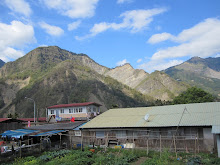
" I have visited Penghu many times in the last four years. But I never have been able to record a fish market : nowadays, the selling is organized electronically, and no interesting sound is produced. This is not the case here, in Dongshih, where is held every afternoon a traditional fish market. This happen under a wide reverberant space, where all voices are melting into a loud whisper. People come to see the fish and they discuss about the quality, the freshness and the prices of the sea foods lying on the floor. Sometimes a voice annouces something through loudspeakers. Sometimes some big plastic container are pushed and fall, producing a very loud drum sound : "Boum" ! The workers are sorting the fishes, orgazing them into categories, and when the throw them into buckets, it makes a discrete slapping sounds : "Slap" ! But what is the most surprising is when the sea products needs to be put on the floor. The fishes, shrimps and other animals are organized into patterns : lines of small piles, reminding me land art. At least two women are working for doing these patterns of fishes. One is throwing a bucket containg a few fishes, it bounces on the floor with a big "clac !" and glide on the wet concrete floor during several meters "Shhrrrr !", and the second lady catch it and suddenly reverse it, throwing its content on the floor with another short "clac". The operation is repeated many times until the floor of the whole building is covered with piles of fishes.
Then a strident blast of whistle comes from an area. People gathered in this direction. A man holding a notebook wait above one of the piles of fish. When people become attentive, he starts. He's recitating monotonously in taiwanese. His words are decreasing numbers, corresponding to the decreasing price of the fish. When someone decide to buy it at the spoken price, he will give the man his personal name stamp. The guy use it on his notebook, write the price, tear the page, and give it to the customer. Then he restart his vocal process on the next pile of fish. All the potential customers are silent, attentive to the prices. Therefore the man who organize the selling doesn't need to speak very loudly. And if one moves off a little bit, he won't be able to hear correctly the prices. So it is a quite intimate selling, something I've never witnessed in Taiwan ! The sound ambience and different sonic events of this fish market are a very strong experience. For sure customers, fishermen and sellers would be able to recognize it when it'll disappear, replacing the voices of the people by digits on screen... “ (Yannick Dauby)
Seller :
Baskets :
過去四年我去過澎湖很多次,但從沒能錄下魚市場的聲音。現在,大多數魚市場都已電子化操作,沒什麼有趣的聲音好錄。東石魚市場卻不是這麼回事。每天下午的傳統漁市,在一個有著很大回響的空間裡進行,所有的聲音融合成極大的鳴響。人們邊看著陳列在地板上的魚,邊討論魚的品質、新鮮度和價格。有時候是擴音器的放送,有時塑膠籃子被放下倒出漁獲,發出擊鼓一樣的「碰」一聲。工作人員在將於分類,把魚丟進籃子裡時,也會發出魚碰撞的啪啪聲。但最驚訝的是,當他們把魚分堆擺放在地板上,魚、蝦、和其他各種海底生物排列組合的圖樣,漁獲成堆擺出的線條簡直像地景藝術。至少有兩個人在從事這項工作。一個丟擲籃子給另一個,此時籃子先是碰撞地板發出喀喀聲,經過濕漉的水泥地「咻」的一聲移動數尺,然後另一個人接住籃子隨即倒出漁獲,又是另一個碰撞地板的喀喀聲。這樣的動作持續到地板全都擺滿了魚。
一聲長哨,所有人往同一方向聚集。一個拿著一本簿子的男人站在第一落魚堆前,大夥聚精會神,他便開始了。他訕訕地以臺語呢唸著。口中的數字遞減,也就代表魚的價格遞減。一旦有人決定以某個價格購買這堆魚,就會喊停,拿出印鑑給這個男人。男人在簿子上用印、填寫價格,撕下存根聯給買者,移動到下一堆魚繼續重複。所有顧客、買家都靜默不出聲,全心注意著價格,因此喊價者也不用喊得大聲,倒是只要稍不留神或移動腳步,便可能錯過一個好的成交價。
東石魚市場的喊價拍賣方式,使魚販和顧客間的關係變得密切,我在臺灣從沒見過。這裡的聲音環境和豐富多樣的聲音物件,是非常強烈的經驗。當然,未來當這樣的聲音被無聊的機械數位取代時,漁夫、顧客、賣家都還必將認得這些聲音…。(中譯:許雁婷)
Seller :
Baskets :




沒有留言:
張貼留言